Ever wondered what the difference is between porcupine vs echidna. Do you know exactly what an echidna is? Or a porcupine? You’re certainly not alone.
In this article, we’re going to explore the differences between porcupines and echidna. Including their appearance, locations, their habitat, predators, mating habits, and more.
Here’s the quick takeaway answer, then we’ll get into more details…
Porcupine vs Echidna: Porcupines are placental rodents, whereas echidnas are egg-laying mammals and are slightly smaller than porcupines. Both have spines, but Porcupine spines are stronger, sharper, and of more varying length than echidnas. Echidna is more similar to hedgehogs than porcupines.
Porcupine vs Echidna
Ok, that’s a quick description, but there’s more that we’ll go through on some of the major categories where we can provide an accurate comparison between the two.
When you look at pictures of these two animals, it’s relatively easy to see the similarities in their physical appearance once you know what to look for.
However, upon closer inspection, there are several differences that can be observed.
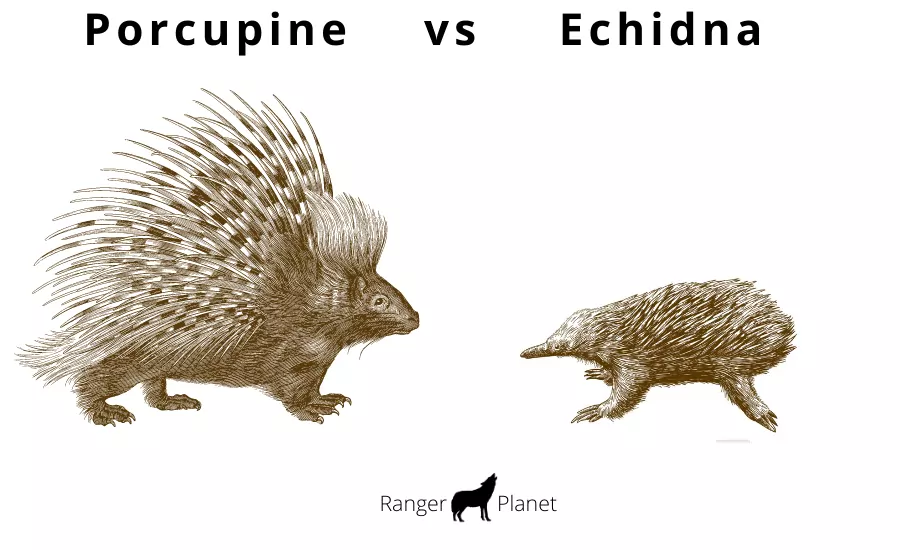
Porcupine vs Echidna – Taxonomy
Looking at both might give you the impression they are members of the same family. However, they are not. Read on to find out more.
Porcupine taxonomy
Porcupines are rodents of the class Rodentia. There are Old World and New World types of Porcupine.
In all, 29 species of Porcupine have been identified. They belong to the families: Erethizontidae (New World Porcupines) and Hystricidae (Old World Porcupines).
Echidna – Taxonomy
Echidnas are commonly known as “spiny anteaters“. They belong to the Order: Monotremata and the Family: Tachyglossidae.
There are four species of Echidnas within three genera classifications.
Here’s a list comparison of the taxonomy of both porcupines and Echidnas.
| Classification | Porcupine | Echidna |
|---|---|---|
| Kingdom | Animalia | Animalia |
| Phylum | Chordata | Chordata |
| Class | Mammalia | Mammalia |
| Order | Rodentia | Monotremata |
| Family | (Various) | Tachyglossidae |
Porcupine vs Echidna
Now we have the taxonomy covered, let’s head into the description and other areas to see the differences between porcupine vs echidna.
Porcupine – Description
As mentioned, porcupines are classed as rodents, with a coat of sharp spines, commonly known as quills, that protect against attack from predators.
Porcupines can vary in variety, they range in size depending on the variety, anything from 2.2 lb (<1kg), up to over 60 lb (27 kg). In terms of size, most porcupines are around 25–36 in (60–90 cm) long, with an 8–10 in (20–25 cm) long tail.
Here are the 18 varieties of New World porcupines:
- Baturite porcupine – (C. baturitensis)
- Black-tailed hairy dwarf porcupine – (C. melanurus)
- Andean porcupine – (C. quichua)
- Streaked dwarf porcupine – (C. ichillus)
- Brazilian porcupine –(C. prehensilis)
- Mexican hairy dwarf porcupine – (C. mexicanus)
- Bahia porcupine – (C. insidious)
- Black dwarf porcupine – (C. nycthemera)
- Rothschild’s porcupine – (C. rothschildi)
- Frosted hairy dwarf porcupine – (C. pruinosus)
- Stump-tailed porcupine – (C. rufescens)
- Roosmalen’s dwarf porcupine – (C. roosmalenorum)
- Santa Marta porcupine – (C. sanctamartae)
- Brown hairy dwarf porcupine – (C. vestitus)
- Coandumirim – (C. speratus)
- Paraguayan hairy dwarf porcupine – (C. spinosus)
- Bicolored-spined porcupine – (C. bicolor)
- North American porcupine – (E. dorsatum)
The porcupine has small eyes, very little neck, and weak hindquarters. This animal relies on its strong front legs to rapidly climb trees in the face of danger.
Most species of porcupines are nocturnal but some are active during the day.
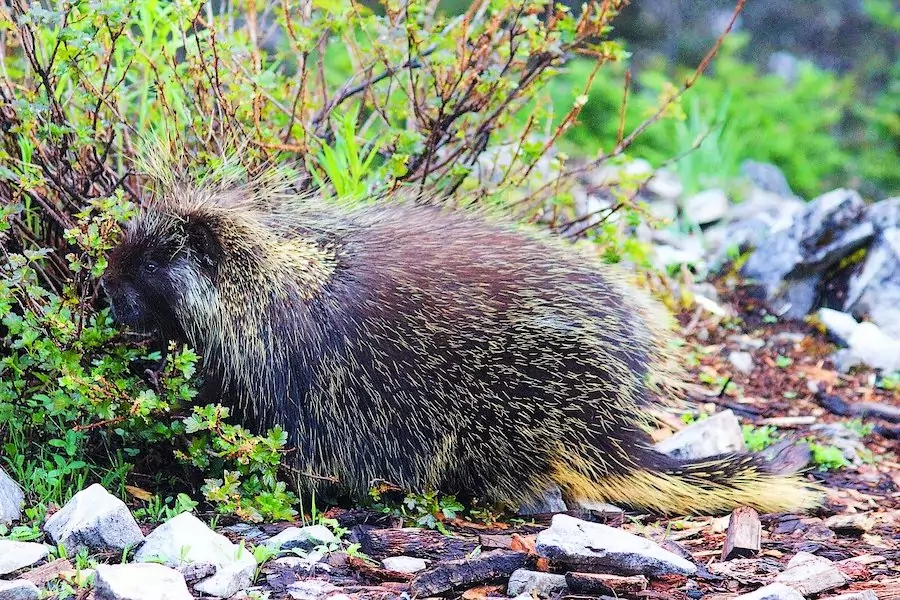
Echidna – Description
The echidna is a solitary, egg-laying mammal. It is the only surviving member of the Monotremata order, which diverged from other mammals, branching out over 100 million years ago.
An echidna is around 12-18 inches in length (30-45 cm), and an adult will weigh around 7.7 lbs (3.5 kg).
Echidnas have a long snout, housing a tongue that is 6-7 inches (15-18 cm) long which is coated with sticky saliva. The Genus name “Tachyglossus” refers to “fast tongue” as they can rapidly extend and retract it to stick and draw in prey like ants and termites.
Their eyes and ears are both small. Their sense of smell and touch are their predominant senses.
In between their sharp spines, and over the rest of their legs, head, and the underside is a coating of course fur. This fur is usually black or brown. There have also been reports of albino echidnas.
Echidnas have four short legs with 4 or 5 strong, sharp claws which they use for digging in the ground and for holding onto their food.
The four identified species of Echidna are:
- Western Long-beaked Echidna (Zaglossus bruijnii)
- Sir David’s Long-beaked Echidna (Zaglossus attenboroughi)
- Eastern Long-beaked Echidna (Zaglossus bartoni)
- Short-beaked Echidna (Tachyglossus aculeatus)
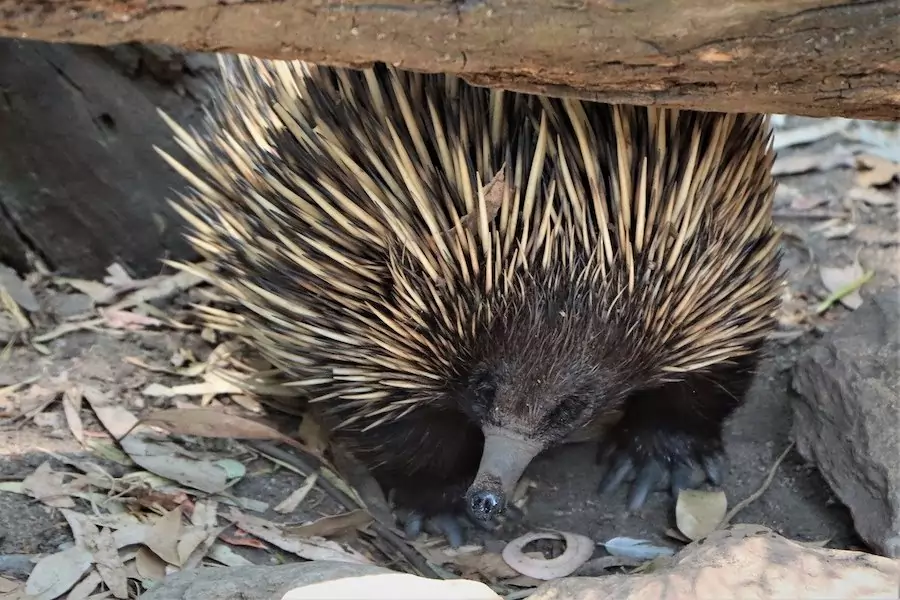
Porcupine – Lifespan
In the wild, porcupines live for around 7 to 12 years. In captivity, their average lifespan is around 15 years.
Echidna – Lifespan
An echidna’s lifespan is thought to be anywhere from 15 to 40 years. However, in the wild this is thought to be nearer to 10 – 15 years. in captivity, they will live for an average of 16 years.
Porcupine – Diet
Porcupines are herbivores and their diet consists mostly of plant matter and vegetables. During the winter months, when food is scarce, they will also eat bark, twigs, and other plant matter. This means they can be considered browsers, rather than granivores.
You can find the full porcupine diet here.
Echidna – Diet
The echidna will eat almost any insect it can fit in its mouth, including ants, termites, grubs, and earthworms. It uses its long tongue to lick up insects.
Specifically, the short-beaked echidna’s diet mainly consists of ants and termites. The long-beaked echidna species typically seeks out and consumes worms and insect larvae.
Surprisingly, echidnas have no teeth. Instead, they have spines that line their mouths and act like teeth. These spines help them grind up their food before they swallow it.
The short-beaked echidna’s preference for termites and ants led to their common name of the ‘spiny anteater’. But their broad diet includes earthworms, beetles, and moth larvae. Furthermore, echidna’s finely tuned sense of smell enables them to find food, and their beak is highly sensitive to electrical stimuli.
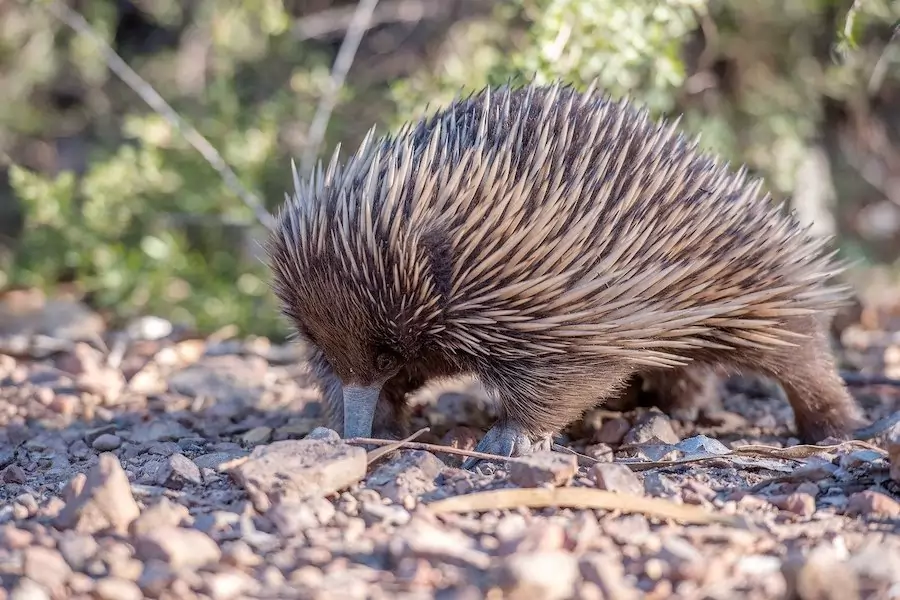
Porcupine – Location in the World
Porcupines are found across many continents, except for the Arctic, Antarctic, Australia, New Zealand, Greenland, and Madagascar.
Mostly, porcupines are native to North America, Central America, South America, Africa, and some of Europe.
Echidna – Location in the World
Echidnas are Australia’s most widespread and native mammal. They’re found predomineently throughout mainland Australia, New Guinea. They’re also found in Tasmania, King Island, Flinders Island, and Kangaroo Island. Inhabiting biomes from deserts to snowy alpine mountains and forests.
Porcupine – Habitat
Porcupines are forest-dwelling animals that prefer to live in trees, caves, or rocky outcrops.
They can be seen in habitats that are temperate, subtropical, or tropical. They are also found in elevations anywhere between sea level and 18,700 ft (5,700 meters).
These porcupine habitats typically include coniferous and deciduous forests, woodlands, shrubland, grasslands, deserts, and wetlands.
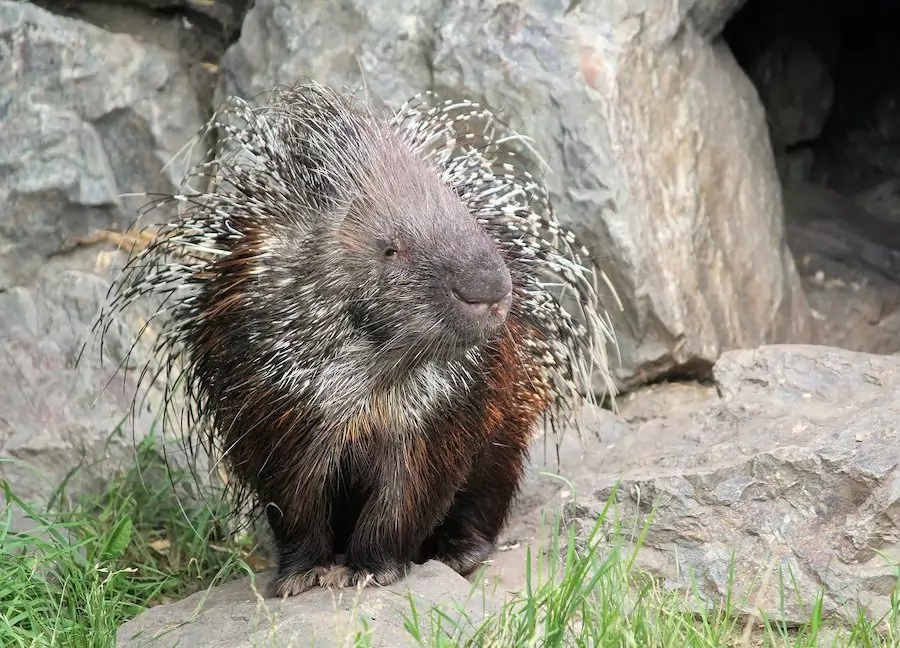
Echidna – Habitat
Echidna habitats include rocky outcrops, hollow logs, and tree trunks hollows as well as among roots. They are commonly found in woodlands, forests, deserts, snow-capped mountain regions, and shrublands. They are also often found in urban environments and semi-rural locations.
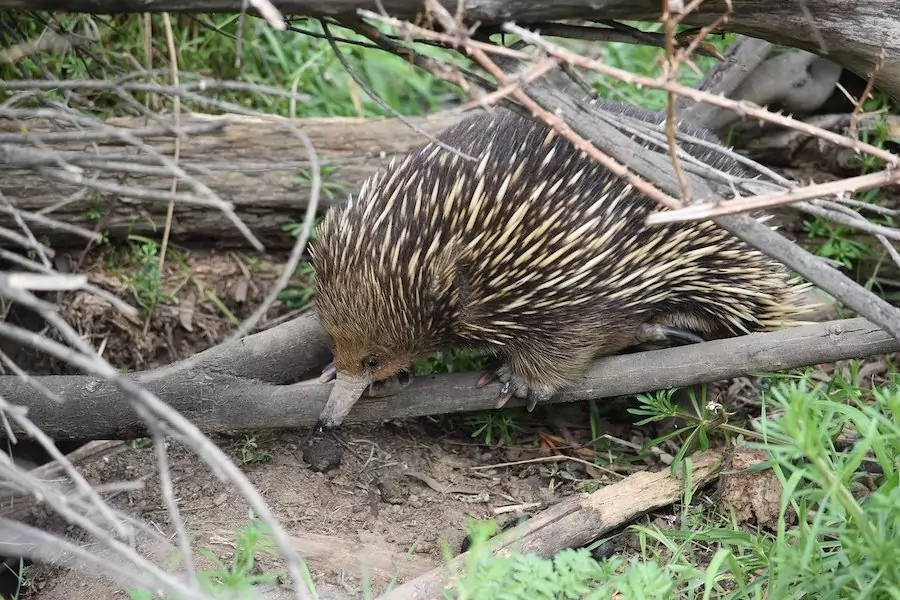
Porcupine – Predators
Strangely, Porcupines can be hunted by a number of predators despite their defenses, such as bobcats, mainly in Canada, fishers mostly in North America, mountain lions, coyotes, and are even sometimes attacked by domestic dogs.
Despite popular myth, when defending itself, a porcupine cannot “shoot” its quills.
A porcupine’s best defense is to stay immobile and ‘play dead’. But if attacked the porcupine will rear up and their quills will stick into the attacker, causing pain.
The quills are not poisonous or barbed, but they are very sharp and difficult to remove from wounds.
Echidna – Predators
Predators depend largely on their location. Adult echidnas are occasionally taken by dingoes, eagles, and packs of wild dogs or dingos. Young echidnas can be attacked and eaten by animals such as wild dogs and dingos, feral cats, goannas – the large monitor lizards, snakes, Tasmanian devils, and birds of prey.
Porcupine – Mating, and Rearing
Porcupines breed only once a year. They find a mate by olfactory and vocal cues. Mating is conducted in both monogamous and polygamous relationships.
Den sites must be prepared for the female to bear young. The dens are lined with bedding material of grass, moss, and cedar needles.
After a pregnancy period of 180-220 days, the female gives birth to between one and five young (usually two or three).
Baby porcupines are commonly called “porcupette”. They typically weigh around 16-oz (450g) at birth, have soft quills on their body but not on their face or belly, and are covered with a thin layer of black downy fur.
The young stay with their mother for a period of nursing for about 7–8 months until they’re fully independent.
With their quills not yet developed. They are born without teeth or claws, making them vulnerable to predators. The young remain at their mother’s side for about 9 months before venturing out on their own.
As a porcupine grows older, its quills become more brittle and may fall out during periods of molting.
Echidna – Mating, and Rearing
For echidna, the breeding season stems from June through September. Strong pheromones are emitted by both males and females to attract a mate. A male has been known to follow a female around for up to a month before she will decide to mate with him.
The female gestation period is fairly short at around 16-28 days.
From birth, echidna young suckle from their mother’s mammary glands within her pouch. They are carried within the pouch for approximately 90 days. From 3 months up to around 9 months, the young will be provided with further protection within a burrow and cared for by the mother who will continue to rear them.
Porcupine – Conservation Status
Although some porcupine species are already extinct, currently, most porcupine species are categorized as Least Concern, Near Threatened, or Vulnerable according to the International Union for Conservation of Nature (IUCN).
Echidna – Conservation Status
Since the 1960s, long-beaked echidnas are experiencing a population decline of as much as 80%. Mainly due to overhunting and habitat loss and are considered to be at high risk of extinction.
The short-beaked echidna, however, is not considered at risk and is a very common species in Australia.
Porcupine vs Echidna – Overview

Porcupine vs Echidna – More wildlife help
We hope this has provided you with a good overview of Porcupine vs echidna. They appear similar in many ways, but you should now at least be able to tell them apart physically.
You may also want to know how to tell the difference between a hedgehog and a porcupine.
Be sure to check out our other articles, such as Elk vs Moose. And also be sure to subscribe to the Ranger Planet YouTube Channel for more wildlife videos.

